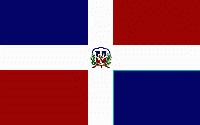 Located in the Caribbean Sea, the Dominican Republic covers an area
of 18,703 square miles (48,440 square kilometers), occupying the eastern portion of Hispaniola,
the second largest island of the Antilles. It shares the island with Haiti but the two neighbors have
little in common. The inhabitants of Haiti are predominantly black, have French and African
cultural roots, and live in an overpopulated and poor environment. In contrast, the population of
the Dominican Republic is predominantly mulatto or white, Hispanic in culture, and belongs to
a country that suffers from some environmental deterioration but also has areas of lush vegetation
and rich farmland.
Located in the Caribbean Sea, the Dominican Republic covers an area
of 18,703 square miles (48,440 square kilometers), occupying the eastern portion of Hispaniola,
the second largest island of the Antilles. It shares the island with Haiti but the two neighbors have
little in common. The inhabitants of Haiti are predominantly black, have French and African
cultural roots, and live in an overpopulated and poor environment. In contrast, the population of
the Dominican Republic is predominantly mulatto or white, Hispanic in culture, and belongs to
a country that suffers from some environmental deterioration but also has areas of lush vegetation
and rich farmland.
Official Name. Dominican Republic.
Capital. Santo Domingo.
Area. 18,703 square miles (48,440 square kilometers).
Population (1982 estimate). 5,752,500; 307.6 persons per square mile (118.8 persons per
square kilometer); 52 percent urban, 48 percent rural.
Major Language. Spanish (official).
Major Religion. Roman Catholic.
Literacy. 70 percent.
Highest Peak. Pico Duarte.
Major Rivers. Isabela, Macoris, Ozama, Soco.
Form of Government. Republic.
Head of State and Government. President.
Legislature. National Congress.
Voting Qualifications. Citizens who are 18 years old, excluding members of the armed
forces and the police, may vote.
Political Divisions. 26 provinces.
Major Cities (1981 census). Santo Domingo 1,313,172, Santiago 278,638, La Romana
91,571, San Pedro de Macoris 78,562, San Francisco de Macoris 64,906.
Chief Manufactured and Mined Products. Refined sugar, textiles, pharmaceuticals, bauxite,
silver, gold.
Chief Agricultural Products. Crops sugarcane, coffee, tobacco, cocoa, rice, potatoes, beans,
cassavas, bananas (plantains). Livestock cattle, goats, horses, donkeys.
Monetary Unit. 1 Dominican Republic peso = 100 centavos.
---------------------------------------------------------
Excerpted from Compton's Interactive Encyclopedia
Copyright (c) 1994, 1995 Compton's NewMedia, Inc. All Rights Reserved